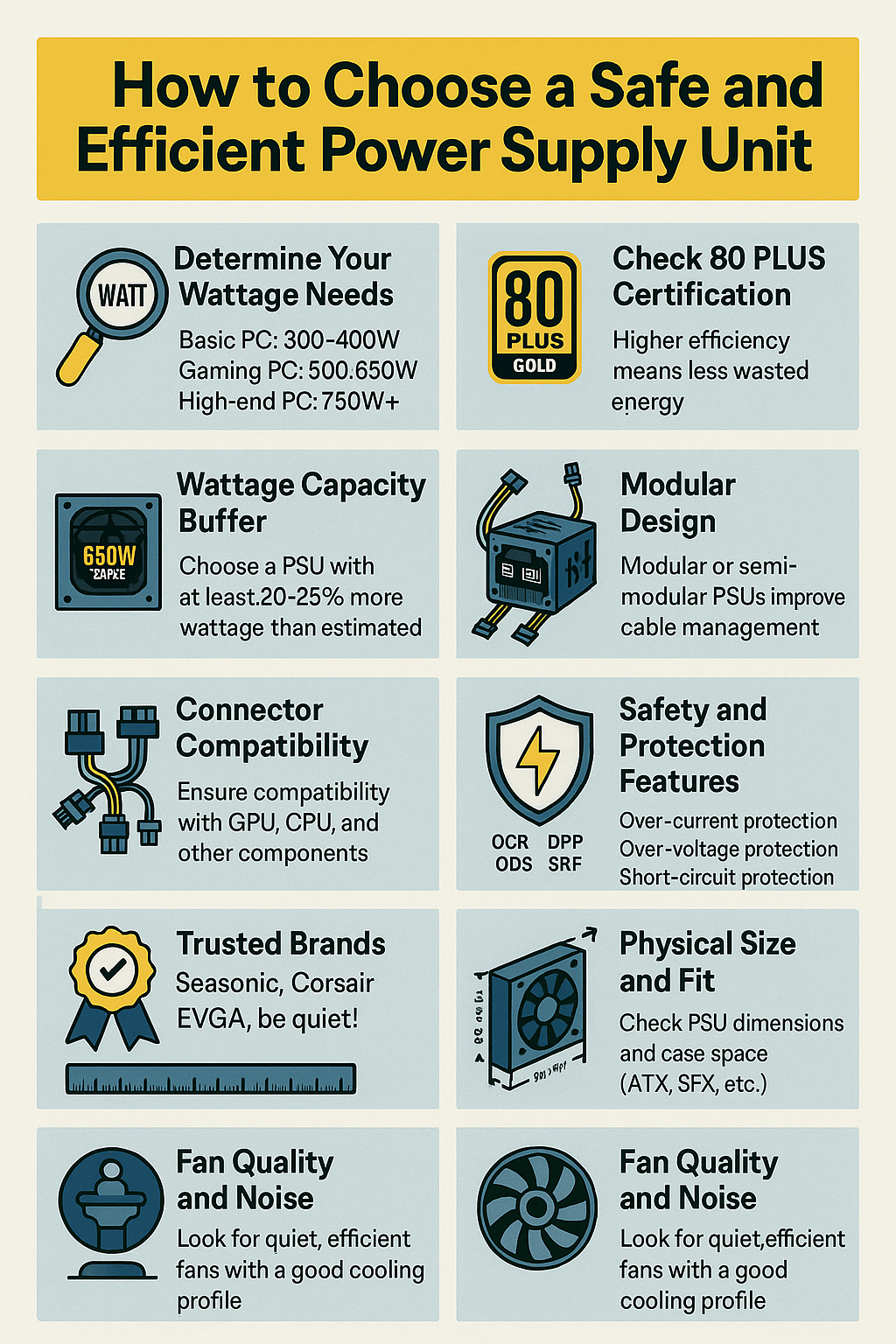One of the most overlooked but most critical components in a computer build is the Power Supply Unit (PSU). While it doesn’t directly improve performance, it powers every component in your PC — and a bad PSU can cause crashes, instability, or even hardware damage.
In this article, you’ll learn how to choose the right power supply for your system, how to calculate power needs, and what features to look for in 2025.
What Is a Power Supply Unit?
A PSU converts AC electricity from your wall outlet into DC power used by your computer components. It distributes power to the:
- CPU
- GPU
- Motherboard
- Storage drives
- Cooling systems
- And more
A high-quality PSU ensures system stability, longevity, and safety.
1. Determine Your Wattage Requirements
The first step is to calculate how much wattage your system needs.
Typical Wattage Ranges:
| PC Type | Recommended Wattage |
|---|---|
| Basic Office PC | 300–400W |
| Mid-Range Gaming PC | 500–650W |
| High-End Gaming/Workstation | 750–1000W+ |
You can use online tools like the PCPartPicker PSU Calculator to get an accurate estimate.
Important Tips:
- Leave headroom (30–50W) for future upgrades or overclocking.
- Don’t buy a PSU that’s just “enough.” Efficiency and lifespan drop at max load.
2. Look for 80 PLUS Certification
The 80 PLUS certification indicates how efficient a PSU is at converting power. The higher the rating, the less power is wasted as heat.
80 PLUS Tiers:
- 80 PLUS White (basic, not common anymore)
- 80 PLUS Bronze (good for budget builds)
- 80 PLUS Silver (less common)
- 80 PLUS Gold (excellent balance of cost and efficiency)
- 80 PLUS Platinum / Titanium (for high-end or enterprise systems)
Why It Matters:
- Efficient PSUs run cooler, quieter, and last longer.
- You save on electricity over time.
- Less heat = more stable performance.
3. Choose the Right Wattage Capacity
Don’t overpay for a 1000W PSU if you only need 500W — but also don’t risk running out of power.
Use This Rule of Thumb:
- Add up your estimated wattage
- Add at least 20% buffer
- Pick a PSU from a reputable brand with matching capacity
For example, if your build needs 450W:
- 450W x 1.2 = 540W → Choose a 600W–650W PSU
4. Understand Modularity: Full, Semi, or Non-Modular
Fully Modular
- All cables are detachable
- Best for cable management and airflow
- Premium price, ideal for clean builds
Semi-Modular
- Main motherboard/CPU cables are fixed
- Other cables (PCIe, SATA) are detachable
- Good middle ground
Non-Modular
- All cables are attached
- Cheapest, but harder to manage and less tidy
Tip:
For smaller cases or glass-sided builds, choose modular or semi-modular for better airflow and cleaner aesthetics.
5. Check Connector Compatibility
Make sure your PSU has enough connectors for your system:
- 24-pin ATX (for motherboard)
- 8-pin CPU (EPS) (some high-end boards need two)
- 6/8-pin PCIe (for GPUs, some cards require 2–3 connectors)
- SATA/Molex (for drives and RGB controllers)
If you’re using a high-end GPU, double-check the power connector type — newer models like NVIDIA RTX 4000 series use 12VHPWR (16-pin) connectors.
6. Prioritize Safety and Protection Features
Good PSUs include essential protection mechanisms:
- OCP (Over Current Protection)
- OVP (Over Voltage Protection)
- SCP (Short Circuit Protection)
- OTP (Over Temperature Protection)
These prevent damage in case of surges or component failure.
Stick with brands that comply with UL or CE safety standards.
7. Choose Trusted Brands
Avoid generic, no-name PSUs — they can fail under load and even destroy other components.
Recommended PSU Brands in 2025:
- Corsair
- Seasonic
- EVGA
- be quiet!
- Cooler Master
- ASUS ROG (premium)
- Thermaltake
Tip: Always check reviews and warranty information before buying.
8. Physical Size: Will It Fit in Your Case?
Standard PSUs use the ATX form factor, but not all cases have the same space or clearance.
- Check PSU length in mm
- Some cases require SFX or SFX-L PSUs (smaller builds)
- Confirm there’s space for cables and airflow
9. Fan Quality and Noise Level
Look for silent or semi-passive fans:
- Zero RPM Mode: Fan stays off at low load
- Fluid Dynamic Bearings: Quiet and durable
- Large diameter fans (120mm+): Lower RPM, less noise
High-quality PSUs stay quiet even under load, improving your overall PC experience.
Summary: Choosing the Right PSU
To recap, here’s how to choose a great power supply for your build:
✅ Calculate your wattage (add headroom)
✅ Choose at least 80 PLUS Bronze (preferably Gold or better)
✅ Get modular cables if possible
✅ Ensure all connectors match your components
✅ Buy from trusted brands
✅ Double-check physical size and airflow clearance
The PSU might not be the most exciting part of a PC build, but it’s one of the most important. Investing in a reliable, efficient power supply is investing in the stability, safety, and longevity of your entire system.
